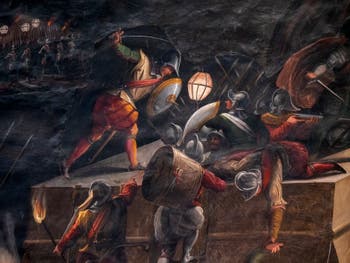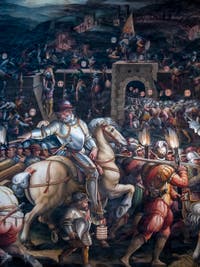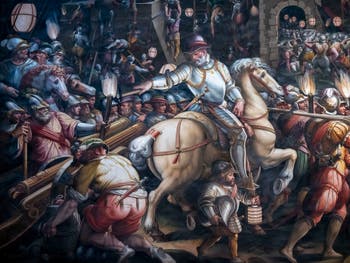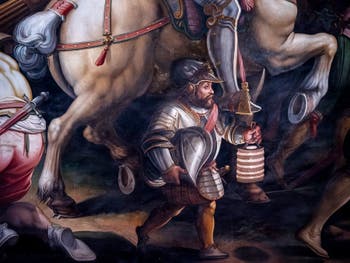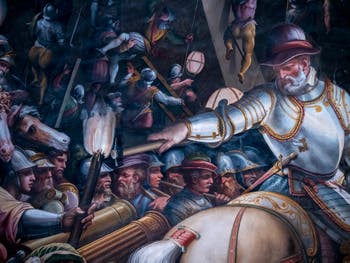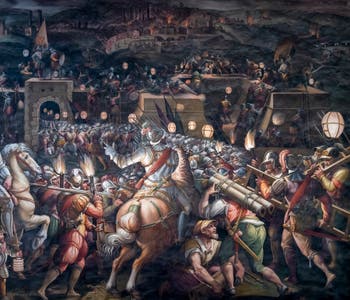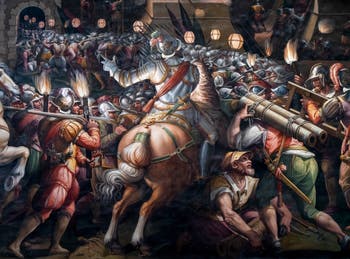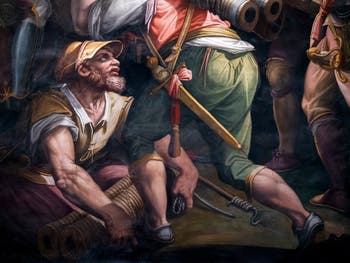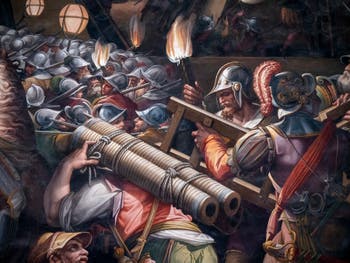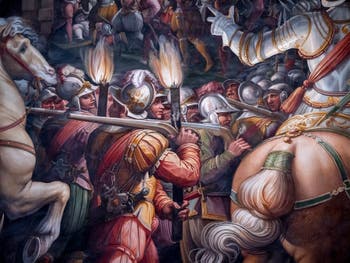Palazzo Vecchio Art Story | Location | Opening Hours Tickets | Authorizations
Art Story Five-Hundred | Tower | Vasari Halls | Dante Mask | Ghirlandaio | Bronzino Sarto Daddi | Salviati | Cortile
Five-Hundred Hall Hall and Ceiling | Ceiling Paintings | Pisa War | Siena War | Sculptures
Siena War Porta Camollia | Port Ercole | Cerca Trova Who Seeks Find
War of Siena “Taking of the Fort of the Porta Camollia” by Giorgio Vasari, Hall of Five Hundred of Palazzo Vecchio in Florence
Fresco - Water Pigments (7,60 x 13 metres) 1568-1571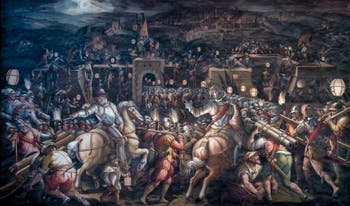
Taking Porta Camollia On the eastern wall of the Hall of the Five Hundred, Giorgio Vasari and Giovanni Battista Naldini represented the capture of Siena fort in front of the Porta Camollia, one of the main gates of the city.
Giorgio Vasari describes this battle as follows:
“The night capture of the forts of Siena was an undertaking through which the Duke (Cosimo I Medici) acquired an outstanding reputation by showing his ability to attack the enemy at home with caution and demonstrating great sagacity.
The event took place on the night of 26 to June 27 1554, and began with the capture of the fort that protected the Porta Camollia followed by the onslaught of the city.”
Giorgio Vasari
The troops of Florence were commanded by the Marquis of Marignano.
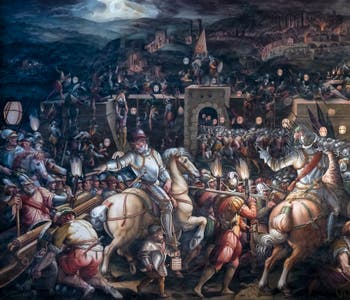
Taking Porta Camollia They left Poggibonsi in the afternoon with 4,500 infantrymen, 100 mules loaded with 20 artillery pieces, 2,000 sappers and 400 Spanish horsemen.
The assault was directed to one of the forts of Siena, the one in front of the Porta Camollia.
It was easily caught with the capture of the guard body consisting of 40 men who were then asleep.
The success of this capture marked the beginning of the Siena War, which lasted 13 months.
After the capture of this fort, the city of Siena was conquered entirely on April 21, 1555.
The fresco shows a night scene lit by lanterns and torches as soldiers climb the walls of the fortress and others enter directly through the front door to the fort.
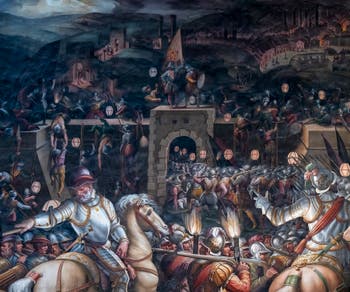
Taking Porta Camollia The condottiere at the head of the troops, the Marquis of Marignano, riding on the left, gives orders for the positioning of the guns while a dwarf accompanies him wearing his salad (helmet) and a lantern.
This Italian condottiere, Gian Giacomo de Medici, Marquis of Marignano, also known as Medeghino, was first a highwayman before becoming a mercenary in the service of the Duke of Florence, but also during his career, of the Dukes of Milan and Charles V.
He was part of the Milanese branch of the Medici family.
The fortune he accumulated as a bandit and condottiere enabled him to help his brother, Giovanni Angelo Medici, to become pope under the name of Pius IV.
Grateful, Pius IV erected in Milan Cathedral a sumptuous funerary monument to the glory of his brother.
Siena War Porta Camollia | Port Ercole | Cerca Trova Who Seeks Find
Five-Hundred Hall Hall and Ceiling | Ceiling Paintings | Pisa War | Siena War | Sculptures
Art Story Five-Hundred | Tower | Vasari Halls | Dante Mask | Ghirlandaio | Bronzino Sarto Daddi | Salviati | Cortile
Palazzo Vecchio Art Story | Location | Opening Hours Tickets | Authorizations
Back to Top of Page


